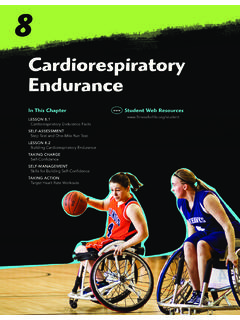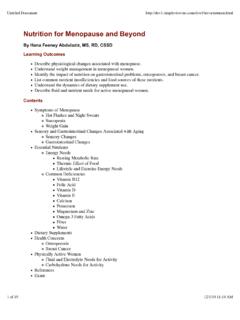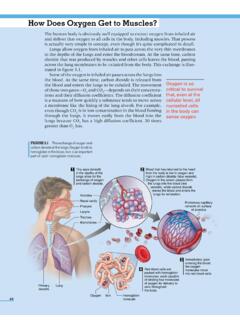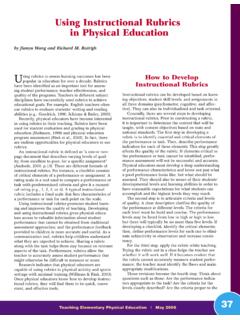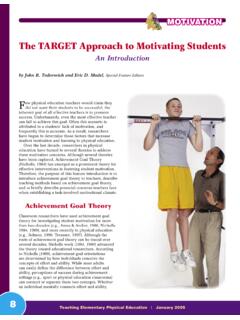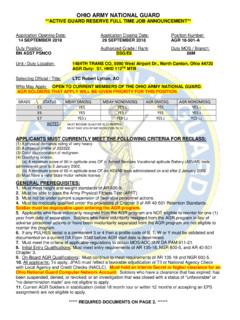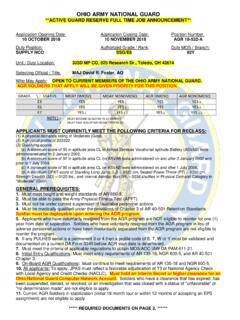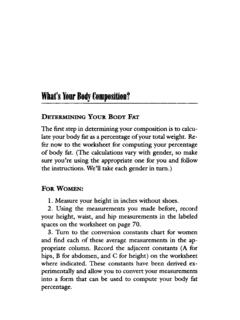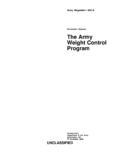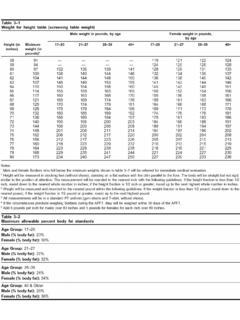Transcription of Lesson Plan 2: Healthy Body Weight - Human Kinetics
1 Health for Life Understanding Your body 1 Lesson plan 2: Healthy body Weight In this Lesson , you ll learn how health is affected by body Weight , body composition, and body fat distribution. You ll also consider how genetics and socioeconomic status can affect an individual s body Weight . AAHE Standards Analyze how genetics and family history can impact personal health. Generate alternatives to health-related issues or problems. Defend the Healthy choice when making decisions. Preparing the Lesson Lesson Objectives 1. Define body mass index (BMI) and identify its strengths and weaknesses as a health assessment. 2. Explain the relationship between health and body fat distribution. 3. Identify two ways in which body Weight is affected by genetics and two ways in which it is affected by socioeconomic status. Preparation 1. Copy Worksheet: Focus on Healthy body Weight , Worksheet: Weighty Problems, and Quiz: Healthy body Weight .
2 2. Open the Lesson 2 PowerPoint slides and set up your projector. Open slide 2 (journal question) so that it is visible when students enter the classroom. Bell Ringer Project slide 2 (journal question) onto the screen or write the question on the board. Make sure that students are on task upon arriving at class and allow them three to five minutes to write. Journal question: Have you ever tested your body fat levels or your fat distribution? If so, what do you remember about the experience? If not, what do you think the experience would be like? Option: Give Quiz: Healthy body Weight as a pretest to assess students knowledge and focus their thinking. Have copies of the quiz on the desks before class or hand them out as students enter the room. Option: Have students read the Health Technology feature and then discuss the Connect questions in small groups. Health for Life Understanding Your body 2 Lesson Focus Review chapter content using the PowerPoint slides for Lesson 2.
3 Have students take notes using Worksheet: Focus on Healthy body Weight . Option: Have students complete Worksheet: Focus on Healthy body Weight . When all students have finished, review answers as a class. Lesson Application 1. Distribute Worksheet: Weighty Problems. 2. Put students into pairs and make sure that each pair has access to the textbook. 3. Instruct the students to work together on the worksheet and to put their pens and pencils down when they are finished. 4. For each question, call on students to share their answer and explain how they got their answer. When you get to the final question, have students go to opposite sides of the room based on their opinion. Once the students are on the appropriate side (one for genetics, one for socioeconomic status), have them discuss their thoughts with their group. After two or three minutes, call on individuals from each group to share the opinions of their group.
4 Once students from both sides have shared, ask if any students want to switch sides based on what they heard. If so, have them explain why they changed their mind. Reflection and Summary Review the day s Lesson by revisiting the Lesson objectives. Formulate each objective as a question and solicit responses. 1. Define body mass index (BMI) and identify its strengths and weaknesses as a health assessment. BMI is a measure of mass or Weight per unit of height. It is easy and inexpensive to administer. However, it does not distinguish between types of tissue ( , muscle, body fat), and its effect on an individual s health can vary from person to person. 2. Explain the relationship between health and body fat distribution. We need a certain amount of body fat for survival (essential fat), and we can live with a certain amount of fat without experiencing problems (storage fat).
5 At some point, however, a person s body fat can negatively affect his or her health, especially if it is carried in the upper body . Upper- body fat, or abdominal fat, is more mobile and active and thus poses a greater danger to health. 3. Identify two ways in which body Weight is affected by genetics and two ways in which it is affected by socioeconomic status. Genetic influences are strong on Weight , height, BMI, body composition, and body fat distribution. Socioeconomic status can affect a person s access to Healthy food and to fitness and recreation opportunities. Health for Life Understanding Your body 3 Evaluate Have students complete Quiz: Healthy body Weight . Option: Collect Worksheet: Focus on Healthy body Weight or Worksheet: Weighty Problems (or both worksheets) and spot-check for accuracy and completion. Reinforcing the Lesson Take It Home Encourage students to visit the website of the Centers for Disease Control and Prevention and read more about the obesity epidemic in the United States.
6 Challenge Activity Have students research one method of assessing body composition and create a one-page handout explaining how the method works, what is required to make it as accurate as possible, how accurate it can be, and (if applicable) where a person could go in the community to get the test done.


